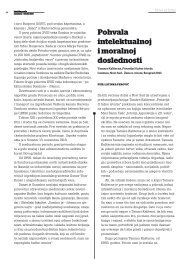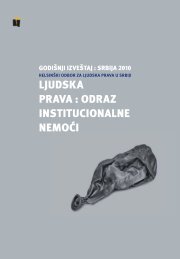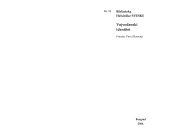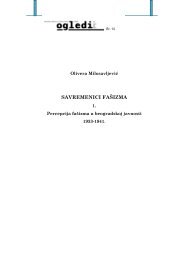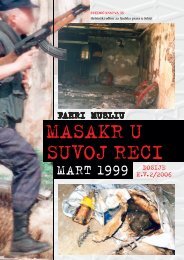DEMOCRACY AND SECURITY in Southeastern Europe, No 1
DEMOCRACY AND SECURITY in Southeastern Europe, No 1
DEMOCRACY AND SECURITY in Southeastern Europe, No 1
You also want an ePaper? Increase the reach of your titles
YUMPU automatically turns print PDFs into web optimized ePapers that Google loves.
44<br />
be used <strong>in</strong> launch<strong>in</strong>g a strategic air offensive aga<strong>in</strong>st<br />
Russia. However, “the successful adoption of a Rh<strong>in</strong>e<br />
strategy <strong>in</strong> Western <strong>Europe</strong> is militarily impracticable<br />
because of the overall shortages of forces. The <strong>No</strong>rth<br />
Atlantic Treaty Countries will have <strong>in</strong>sufficient forces<br />
to prevent Western <strong>Europe</strong>, exclud<strong>in</strong>g the United<br />
K<strong>in</strong>gdom, from be<strong>in</strong>g overrun. Therefore, there are<br />
clear advantages to be ga<strong>in</strong>ed from hold<strong>in</strong>g the Italo-<br />
Austrian bridgehead <strong>in</strong> Southern <strong>Europe</strong> <strong>in</strong> order to<br />
reta<strong>in</strong> a foothold for the subsequent counter-offensive<br />
and to contribute to the defense of the United K<strong>in</strong>gdom<br />
base.” 5<br />
It was believed <strong>in</strong> the West that the Ljubljana Gap - the<br />
valley <strong>in</strong> which the Slovenian capital lies - could have<br />
served for a rapid Soviet attack from Hungary <strong>in</strong>to<br />
Italy, although this was never as much of a priority for<br />
NATO as the Central Front. At a m<strong>in</strong>imum, therefore,<br />
to deny Yugoslavia to the Soviet Union was to make<br />
the defense of Italy and Austria easier.<br />
American military representatives had warned the Yugoslav<br />
government that, <strong>in</strong> the case of war, the Russians<br />
would try to break through Slovenia <strong>in</strong>to Italy<br />
and from Bulgaria to Albania, cutt<strong>in</strong>g Yugoslavia off<br />
from Greece. 6 Although the third-largest regular land<br />
force <strong>in</strong> <strong>Europe</strong> <strong>in</strong> 1948, the Yugoslav People’s Army<br />
(JNA) could not withstand such a susta<strong>in</strong>ed assault.<br />
The Yugoslav authorities were told that their defensive<br />
capabilities would be considerably enhanced if Yugoslavia<br />
would be will<strong>in</strong>g, <strong>in</strong> conjunction with the Allies,<br />
to consider <strong>No</strong>rtheastern Italy, Yugoslavia and Greece<br />
as a s<strong>in</strong>gle defense area. Forces and equipment were<br />
subsequently allocated to the defense of the Ljubljana<br />
Gap <strong>in</strong> the north and the Vardar valley approach to<br />
the Salonika area <strong>in</strong> the south. 7<br />
U.S. assistance to Tito <strong>in</strong>cluded the provision of aircraft<br />
and other military equipment, plus a cont<strong>in</strong>u<strong>in</strong>g economic<br />
aid program that won Yugoslavia a unique and<br />
favored position among all Communist countries. The<br />
allocations of American military aid to Yugoslavia — <strong>in</strong><br />
tanks, pieces of heavy artillery and jet planes — were<br />
used to equip the units of the JNA <strong>in</strong> the area of the<br />
Ljubljana Gap and were generally kept <strong>in</strong> that area. 8<br />
Yugoslavia thus became an important, albeit secondary<br />
factor <strong>in</strong> Western defense plann<strong>in</strong>g and there was<br />
some discussion about the possibility of br<strong>in</strong>g<strong>in</strong>g it<br />
closer to NATO. That discussion cont<strong>in</strong>ued <strong>in</strong>to the<br />
mid-1950s as Yugoslavia and the Soviet Union flirted<br />
with full reconciliation after Stal<strong>in</strong>’s death. However,<br />
this was never a likely prospect. Tito had repeatedly<br />
assured American and British representatives that Yugoslavia<br />
would come <strong>in</strong> immediately on the Western<br />
side <strong>in</strong> the event of an outbreak of war with the Soviet<br />
block <strong>in</strong> <strong>Europe</strong>. 9 Still, he was determ<strong>in</strong>ed to<br />
avoid what might have been regarded as a “provocative”<br />
association with an “aggressive” alliance, and<br />
also to avoid the appearance of commitment to either<br />
bloc. 10<br />
Tito told the British government that the Yugoslav people<br />
“understood and approved” the steps taken by<br />
their government to improve relations with the West.<br />
However, Tito was conv<strong>in</strong>ced that jo<strong>in</strong><strong>in</strong>g NATO<br />
would not be understood by the Yugoslav public. “It<br />
was essential,” he said, “to proceed by stages <strong>in</strong> this<br />
way, carry<strong>in</strong>g public op<strong>in</strong>ion along. Yugoslavia would<br />
be more useful to the West as a united nation outside<br />
NATO , than <strong>in</strong> it and divided.” 11<br />
Follow<strong>in</strong>g his famous rapprochement with Khrushchev<br />
<strong>in</strong> 1955, Tito kept his relations <strong>in</strong> balance between the<br />
Soviet Union and the United States. He exploited Yugoslavia’s<br />
position <strong>in</strong> the Cold War, play<strong>in</strong>g one side<br />
aga<strong>in</strong>st the other with various benefits <strong>in</strong> trade and<br />
both f<strong>in</strong>ancial and military assistance.



